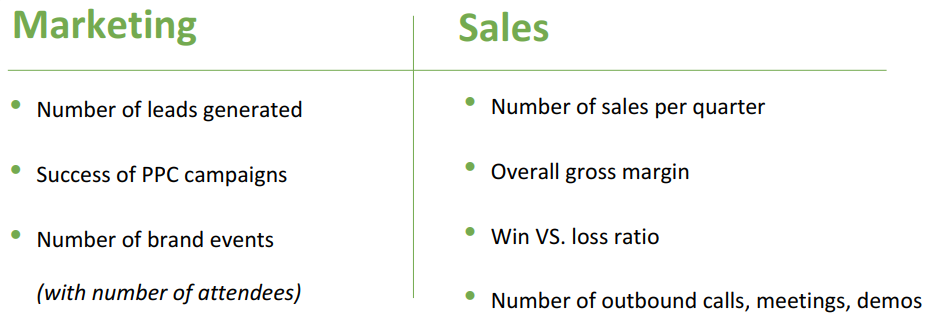In the past, professionals have joked that companies always waste half of their marketing spend—they just don’t know which half. In this session, learn how marketing teams can keep careful track of their marketing team’s efforts, spend, and productivity for increased ROI.
Watch the Replay
Presenter: Peter Velikin (CMO, CEIPAL)
Why You Need Metrics for Marketing
Every company needs a marketing team. The problem is that many people still consider marketing a waste of money. Especially in the staffing industry, where margins are low and budgets are tght, it’s difficult to justify investing in marketing teams.
But the reality is that marketing teams significantly contribute to a company’s overall profitability. As marketers, it’s your responsibility to demonstrate the value you bring to the team. And to do this, you need metrics. Unfortunately:
- Over 20% of marketers “rarely” measure marketing campaign successes
- Only 39% of companies say their marketing strategy is effective
- And marketers with a documented strategy are 313% more likely to report success than their counterparts
In this session, learn what metrics to measure to gauge your team’s success and track performance toward achieving goals.
Demand Generation Metrics
Demand generation is a pillar of any marketing team. Making sure that the top of the funnel is consistently filled with high-quality, viable leads is a huge driver of business. Without these leads, sales has no way to close sales.
Marketing teams generate these leads through a variety of channels. Digital marketing on social media is a huge avenue for inexpensive leads. Hosting and attending events (either virtually or in-person) is another tried-and-true way to fill the funnel. However you’re focusing on generating demand, make sure you’re measuring these metrics:
- Cost per lead for every campaign and/or channel
- Conversion rate of leads into deal
- Average value of deals/channel
Remember to be realistic about these numbers. Just because a channel brings in a few cost-effective leads, that doesn’t guarantee it produces a high volume of leads. Focus your marketing efforts on where you can make the biggest impact per channel.
Having these metrics will help you track your team’s internal progress. But once you have these metrics, you can develop another set of data focused on justifying your marketing efforts to your leadership. These metrics include:
- Business generated by your campaigns. (# of new deals and associated revenue)
- Cost of new business for your campaigns. (cost per deal and cost of recurring dollars of revenue)
Remember: these are the only metrics a senior leadership team cares about. Everything else is unnecessary detail.
Brand Building Metrics
Demand generation metrics are relatively easy to measure. Brand building, however, is a bit more difficult. Because “brand” is an abstract concept, breaking it down into numbers can be a challenge for many marketers.
But the reality is that measuring the success of your brand is a huge performance indicator. Customers trust brand, and the more established your brand is, the better your sales team can perform. Here are a few metrics to help you measure your company’s brand.
- Share of voice. This helps determine how your brand is performing relative to competitors. Measure the number of media articles & social media discussions about your company VS. the entire industry.
- Ranking on 3rd party sites. This helps determine how your company is perceived by potential customers researching your services.
- Net promoter score. This helps calculate how many of your customers are happy with your services, versus those who are not. To calculate your score:
- Count the # of clients who rate you <8/10
- Subtract the # of clients who rate you >3/10
- Divide the # by the total # of reviews received
Many staffing firms become discouraged when they first measure the brand’s impact. For those just beginning, here are a few tips to help increase your brand presence.
- Participate in thought leadership. Conduct an industry report on a hot topic, publish an eBook, or host a webinar. Creating thought leadership content establishes your brand as a credible source of information in the industry.
- Run review campaigns. Engage with your current client base and solicit their reviews on third party sites. This will increase your exposure to prospective customers researching your services.
- Collaborate. Team up with respected industry leaders for events, round tables, or even social media campaigns. Getting your name out there is important for brand recognition.
Accountability Metrics
In any organization, marketing and sales work very closely. The success of the marketing team directly impacts the success of the sales team and vice versa.
To make this partnership between marketing and sales as successful and possible, it’s important to define what each team is accountable for. The below t-chart is a mock example of the different metrics each division is accountable for per quarter.
Getting Started
Here’s an example use case for staffing firms to get started with success metrics:
- Monitor the total # of client leads generated with every channel
- Calculate the % of leads your team connects with
- Calculate your win vs. loss ratio per lead
- Calculate the overall value of the client per lead
Creating a system where you can consistently measure the efforts of your marketing team won’t happen overnight. Ultimately, it will take time and effort. But the results are worth it. By breaking down your work into concrete and actionable datasets, you put your team in a much stronger position for success.












